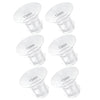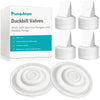You will not be allowed to compare more than 4 products at a time
View compareFrequently Asked Questions
- Q: What are Haakaa Nipple Shields made of? A: Haakaa Nipple Shields are made of 100% food-grade silicone, ensuring safety for both mothers and babies.
- Q: How do Haakaa Nipple Shields help with breastfeeding? A: These nipple shields assist mothers facing latch difficulties, flat or inverted nipples, and help protect sore or cracked nipples, allowing for a smoother breastfeeding experience.
- Q: Are Haakaa Nipple Shields safe for use? A: Yes, Haakaa Nipple Shields are BPA, PVC, phthalate, and lead-free, making them a safe choice for breastfeeding.
- Q: What is the difference between the round shape and the cut shape of Haakaa Nipple Shields? A: The round shape provides a traditional nipple feel, while the cut shape enhances skin contact, allowing babies to feel their mother's body temperature for a more natural experience.
- Q: How do I clean and care for Haakaa Nipple Shields? A: It is recommended to wash them before and after each use. While they are dishwasher safe, hand washing in warm soapy water is advised. To sterilize, use a steam sterilizer or boil in water for 2 to 3 minutes.
- Q: Can I use Haakaa Nipple Shields if I have a fast milk flow? A: Yes, the variable flow nipple design helps prevent choking by regulating milk flow, making it suitable for babies with a fast milk flow.
- Q: What is included in the Haakaa Nipple Shields package? A: Each package includes 2 nipple shields and 1 carry case for convenient storage and protection.
- Q: How do I encourage my baby to accept the Haakaa Nipple Shields? A: Express a few drops of milk into the shield before attaching it to encourage your baby to latch on easily.
- Q: What is the size of the Haakaa Nipple Shields? A: The nipple shields are designed with a suitable size to fit most breast shapes, ensuring comfort and functionality.
- Q: Are Haakaa Nipple Shields suitable for all mothers? A: Yes, they are designed to meet various needs, including those of mothers with different nipple shapes and breastfeeding challenges.












